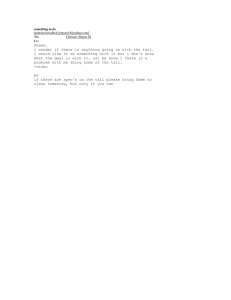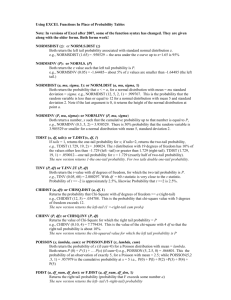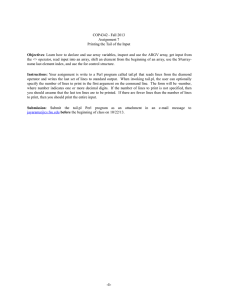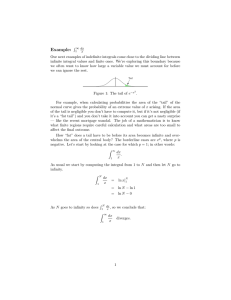Using EXCEL Functions In Place of Probability Tables z
advertisement
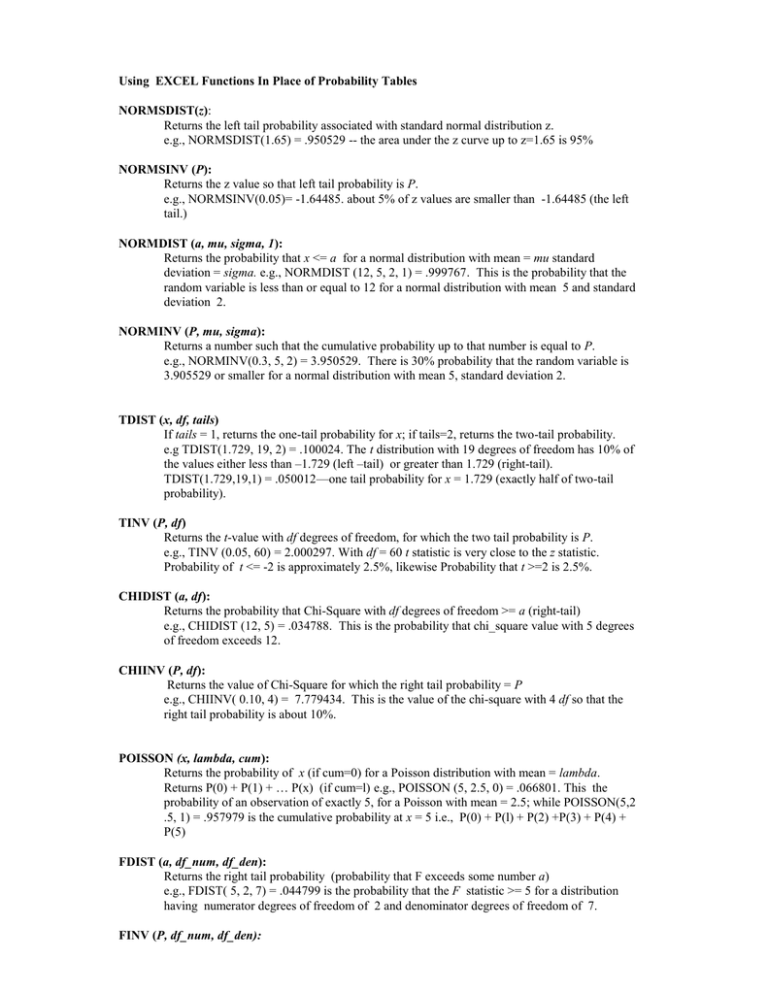
Using EXCEL Functions In Place of Probability Tables NORMSDIST(z): Returns the left tail probability associated with standard normal distribution z. e.g., NORMSDIST(1.65) = .950529 -- the area under the z curve up to z=1.65 is 95% NORMSINV (P): Returns the z value so that left tail probability is P. e.g., NORMSINV(0.05)= -1.64485. about 5% of z values are smaller than -1.64485 (the left tail.) NORMDIST (a, mu, sigma, 1): Returns the probability that x <= a for a normal distribution with mean = mu standard deviation = sigma. e.g., NORMDIST (12, 5, 2, 1) = .999767. This is the probability that the random variable is less than or equal to 12 for a normal distribution with mean 5 and standard deviation 2. NORMINV (P, mu, sigma): Returns a number such that the cumulative probability up to that number is equal to P. e.g., NORMINV(0.3, 5, 2) = 3.950529. There is 30% probability that the random variable is 3.905529 or smaller for a normal distribution with mean 5, standard deviation 2. TDIST (x, df, tails) If tails = 1, returns the one-tail probability for x; if tails=2, returns the two-tail probability. e.g TDIST(1.729, 19, 2) = .100024. The t distribution with 19 degrees of freedom has 10% of the values either less than –1.729 (left –tail) or greater than 1.729 (right-tail). TDIST(1.729,19,1) = .050012—one tail probability for x = 1.729 (exactly half of two-tail probability). TINV (P, df) Returns the t-value with df degrees of freedom, for which the two tail probability is P. e.g., TINV (0.05, 60) = 2.000297. With df = 60 t statistic is very close to the z statistic. Probability of t <= -2 is approximately 2.5%, likewise Probability that t >=2 is 2.5%. CHIDIST (a, df): Returns the probability that Chi-Square with df degrees of freedom >= a (right-tail) e.g., CHIDIST (12, 5) = .034788. This is the probability that chi_square value with 5 degrees of freedom exceeds 12. CHIINV (P, df): Returns the value of Chi-Square for which the right tail probability = P e.g., CHIINV( 0.10, 4) = 7.779434. This is the value of the chi-square with 4 df so that the right tail probability is about 10%. POISSON (x, lambda, cum): Returns the probability of x (if cum=0) for a Poisson distribution with mean = lambda. Returns P(0) + P(1) + … P(x) (if cum=l) e.g., POISSON (5, 2.5, 0) = .066801. This the probability of an observation of exactly 5, for a Poisson with mean = 2.5; while POISSON(5,2 .5, 1) = .957979 is the cumulative probability at x = 5 i.e., P(0) + P(l) + P(2) +P(3) + P(4) + P(5) FDIST (a, df_num, df_den): Returns the right tail probability (probability that F exceeds some number a) e.g., FDIST( 5, 2, 7) = .044799 is the probability that the F statistic >= 5 for a distribution having numerator degrees of freedom of 2 and denominator degrees of freedom of 7. FINV (P, df_num, df_den): Returns the F value for which the right tail probability is P. e.g., FINV (0.05, 3, 5) = 5.409447 is the F value for which the right tail probability is 5%.
